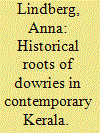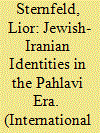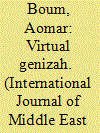|
|
|
Sort Order |
|
|
|
Items / Page
|
|
|
|
|
|
|
| Srl | Item |
| 1 |
ID:
132270


|
|
|
|
|
| Publication |
2014.
|
| Summary/Abstract |
Dowry payments from the family of the bride to that of the groom were rarely encountered in Kerala during the early twentieth century, but now are almost universal. Based on an examination of historical documents, including legislative debates, court cases, and reports, the way dowry was explained in the past is compared with the results of 200 contemporary interviews to determine its current rationale. Nowadays, making an obligatory payment for the maintenance of a wife, adherence to a social norm, and guaranteeing a woman's good treatment have displaced earlier arguments related to inheritance, status in the social hierarchy, or a woman's ability to provide for herself. Although several blurred traditions have been cited to account for dowries, they seem to have flourished in times of social inequity and uncertainty: the 1930s, 1970s, and 1990s. The emphasis on patriarchal nuclear families has created a mentality that a woman must pay for the privilege of being married and living securely.
|
|
|
|
|
|
|
|
|
|
|
|
|
|
|
|
| 2 |
ID:
133311


|
|
|
|
|
| Publication |
2014.
|
| Summary/Abstract |
A few years ago, while conducting archival research on Pahlavi-era Iranian newspapers, I came across a photo from the anti-shah demonstrations that took place in late 1978 and early 1979. It showed a large group of Armenians protesting against the shah. In these years many Iranians and Westerners considered the shah's policies beneficial for religious minorities in Iran. Around the same time, I found a sentence that made this discovery more intriguing. In his seminal work Iran between Two Revolutions, Ervand Abrahamian mentions that throughout the Muhammad Riza Pahlavi era, the opposition to the communist Tudeh party accused it of being controlled by "Armenians, Jews, and Caucasian émigrés." I tried to find references in the current scholarship to Jews participating in the party, which could have earned them their part in this propaganda campaign, but found very little. Having read the important works of Joel Beinin, Orit Bashkin, and Rami Ginat on Jewish revolutionaries, including communists, in the Middle East, I wondered where the Jewish radicals in Iran were. Several factors may contribute to this silence in the historiography: the writing of Iranian history from a Zionist vantage point, a lack of interest in the history of the Iranian left in the postrevolutionary historiography, and an inability to conceptualize the transregional and global nature of the Iranian Jewish community.
|
|
|
|
|
|
|
|
|
|
|
|
|
|
|
|
| 3 |
ID:
127649


|
|
|
|
|
| Publication |
2014.
|
| Summary/Abstract |
Development is conventionally understood in various ways including economic growth, increase of gross domestic product (GDP), rise of per-capita income, improvement of social facilities, political stabilities, and women's empowerment and many other issues, but it finally means bringing positive changes in the life of people. However, development is always contextual because the notion and nature of development often varies from society to society depending on the context of local-societal dynamics. Therefore what is regarded globally accepted model of development can be challenged by the local discourse of development, since local-level perception could contest the universal model. This article addresses such a case of development which is conceptualised from the social and cultural point of view amid everyday experiences of ordinary people's lives. The article contextualises its argument with specific reference to the Khumi people living in the Chittagong Hill Tracts of Bangladesh.
|
|
|
|
|
|
|
|
|
|
|
|
|
|
|
|
| 4 |
ID:
133310


|
|
|
|
|
| Publication |
2014.
|
| Summary/Abstract |
After the establishment of the State of Israel, the Zionist narrative dominated the histories and historiographies of Middle Eastern and North African Jewries. Accordingly, Jews and Arabs were largely kept as distinct binaries divided by the intellectual walls that separated Middle East studies and Jewish studies programs. Local North African and Middle Eastern scholars also silenced or overlooked the Jewish dimension of Middle Eastern societies in the same manner that Israeli scholars ignored the historical connections between Arabs and Jews that existed both before and after 1948. The exclusive, sacred yet ebbing, nationalist paradigm has been plagued with historiographical fissures in recent decades, allowing a new wave of intellectual engagement by a young generation of Jewish and Muslim scholars who began to put the Jew and the Arab back into local and global histories formed through complex social, cultural, economic, and political networks.
|
|
|
|
|
|
|
|
|
|
|
|
|
|
|
|
|
|
|
|
|